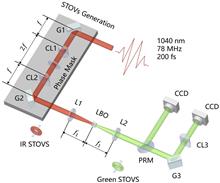
Editor(s): Chenhao Wan; Wei Chen; Qian Cao
Year: 2023
Status: Call for Papers
Chinese Optics Letters (COL) invites high quality articles for a Special Issue on Spatiotemporal optical fields and time-varying optical materials to be published in August 2023.
We give an introduction to the special issue on spatiotemporal optical fields and time-varying optical materials, composed of six articles.
We demonstrate the temporal manipulation of spatiotemporal optical vortices (STOVs) by utilizing Airy pulses. By combining a STOV with an Airy temporal profile, the STOV exhibits nondispersive, self-accelerating, and self-healing features inherited from the Airy pulse propagation. Such features will enhance the control of STOVs in time.
Spatiotemporal optical vortex (STOV) wavepacket carrying transverse photonic orbital angular momentum (OAM) has been extensively studied in the past few years. In this Letter, we propose and study a novel STOV wavepacket with multiple phase singularities embedded in different space–time domains using analytical and numerical approaches. By tuning different parameters used for designing the wavepacket, it is possible to engineer both the magnitude and orientation of the photonic OAM in space–time. The vectorially controllable OAM will pave new avenues and facilitate applications such as novel optical communication, studying complicated quantum systems, and spin-and-OAM interactions.
As a newly discovered type of structured light, a spatiotemporal optical vortex (STOV), which is remarkable for its space–time spiral phase and transverse orbital angular momentum (OAM), has garnered substantial interest. Most previous studies have focused on the generation, characterization, and propagation of STOVs, but their nonlinear frequency conversion remains largely unexplored. Here, we experimentally demonstrate the generation of green and ultraviolet (UV) STOVs by frequency upconversion of a STOV carried near-infrared (NIR) pulse emitted by a high repetition rate Yb-doped fiber laser amplifier system. First, we verify that the topological charge of spatiotemporal OAM (ST-OAM) is doubled along with the optical frequency in the second-harmonic generation (SHG) process, which is visualized by the diffraction patterns of the STOVs in the fundamental and second-harmonic field. Second, the space–time characteristic of NIR STOV is successfully mapped to UV STOV by sum-frequency mixing STOV at 1037 nm and Gaussian beams in the green band. Furthermore, we observe the topological charges of the ST-OAM could be degraded owing to strong space–time coupling and complex spatiotemporal astigmatism of such beams. Our results not only deepen our understanding of nonlinear manipulation of ST-OAM spectra and the generation of STOVs at a new shorter wavelength, but also may promote new applications in both classical and quantum optics.
Simultaneous wireless information and power transfer (SWIPT) architecture is commonly applied in wireless sensors or Internet of Things (IoT) devices, providing both wireless power sources and communication channels. However, the traditional SWIPT transmitter usually suffers from cross-talk distortion caused by the high peak-to-average power ratio of the input signal and the reduction of power amplifier efficiency. This paper proposes a SWIPT transmitting architecture based on an asynchronous space-time-coding digital metasurface (ASTCM). High-efficiency simultaneous transfer of information and power is achieved via energy distribution and information processing of the wireless monophonic signal reflected from the metasurface. We demonstrate the feasibility of the proposed method through theoretical derivations and experimental verification, which is therefore believed to have great potential in wireless communications and the IoT devices.
We report the experimental and theoretical investigation of tilted spatiotemporal optical vortices with partial temporal coherence. The theoretical study shows that the instantaneous spatiotemporal optical vortex is widely variable with the statistical orbital angular momentum (OAM) direction. While decreasing temporal coherence results in a larger variability of OAM tilt, the average OAM direction is relatively unchanged.
Cascaded holography coupled with the secret-sharing scheme has recently gained considerable attention due to its enhanced information processing and encryption capabilities. Here, we propose a new holographic iterative algorithm and present the implementation of cascaded liquid crystal (LC) holography for optical encryption. Each LC layer acts as the secret key and can generate a distinct holographic image. By cascading two LC elements, a new holographic image is formed. Additionally, we showcase the dynamic optical encryption achieved by electrically switching LCs with combined electric keys. This work may offer promising applications in optical cryptography, all-optical computing, and data storage.















